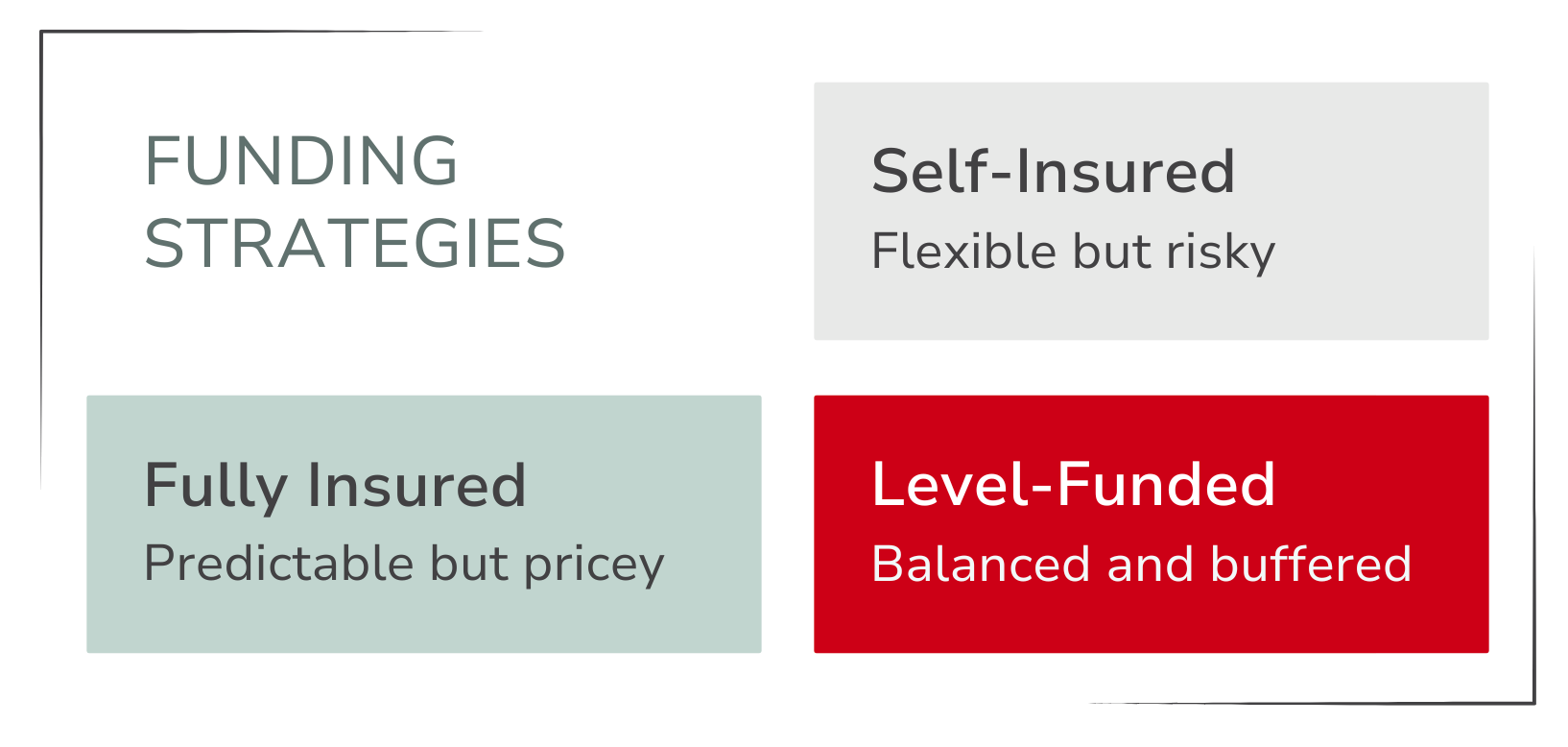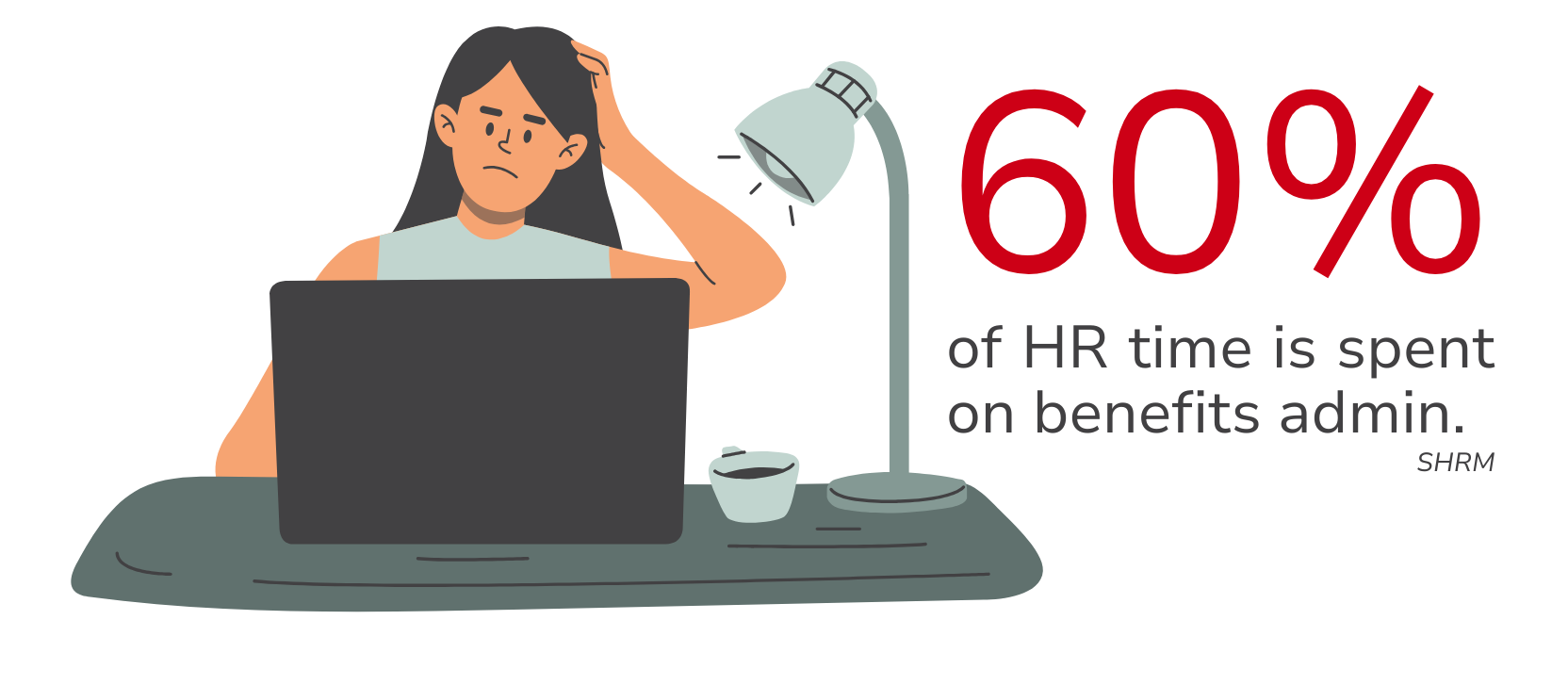5 Tips for Designing a Comprehensive Health Plan for Your Employees
Designing a comprehensive benefits plan can feel overwhelming, with so many choices to make and regulations to follow. But at its core, a strong plan simply answers one question: How can we best support our employees’ health while protecting the business?

In This Article
By understanding your workforce, selecting the right funding strategy and structure, and staying on top of compliance, you can build a benefits strategy that delivers real value to both your people and your bottom line.
Here’s how to get started.
Tip 1: Ask employees what they actually need
It's easy to make assumptions about what employees want from their benefits, but the best way to know for sure is to ask. Simple, well-crafted anonymous surveys allow you to gather real data directly from your team, helping you understand which benefits would truly make a difference in their lives. Tools like online survey platforms can make this process easy and confidential.
A key part of employee benefits planning is asking broad questions that dig deeper, not about personal medical conditions, but about overall priorities and what they would actually use and value day-to-day. For example, would they prioritize mental health support, family coverage, virtual care, or lower out-of-pocket costs? And, as an employer, if you can’t afford everything, knowing what matters most to employees will help you invest wisely.
It’s also important to recognize the diversity within your workforce. Employees’ needs often vary by age, family status, job type, and even location. For example, younger team members may place a higher value on telemedicine and flexibility, while older employees might prioritize chronic condition management and comprehensive in-person care. Striking the right balance can be challenging, but understanding these unique needs is the first step to building a plan that supports everyone.
Tip 2: Choose a funding strategy that fits your goals
One of the most important steps in designing a comprehensive health plan is choosing a funding strategy that fits your company’s goals and budget. The right choice can help you manage costs effectively while still providing great coverage to your team.
Fully Insured
Fully insured health plans are the traditional option many employers are familiar with. In this arrangement, employers pay a fixed monthly premium to a health insurance company, who then assumes the financial risk, handles all claims and administration.
Pros: Predictable monthly costs, minimal administrative burden, and protection from large, unexpected claims.
Cons: Generally higher long-term costs, less flexibility to customize your plan, and limited access to detailed claims data, since carriers typically own the data and share only summary reports.
Self-Insured
On the other hand, self-insured (or self-funded plans) mean your business takes on the financial risk and pays employee claims directly, often with the help of a third-party administrator (TPA).
Pros: Greater flexibility to design benefits, potential cost savings if claims are lower than expected, and more transparent healthcare spending.
Cons: Higher financial risk, potentially unpredictable costs, and the need for stronger administrative support and stop-loss insurance for protection.*
*However, options like level-funded plans and stop-loss insurance can help mitigate some of this financial risk by providing more predictable monthly costs and protection against large, unexpected claims.
Learn more about self-funded plans: https://resources.planstin.com/blog/self-fundedbenefits
Consumer-Directed Health Plans
Consumer-directed health plan (CDHP) options are another approach that can work with either funding model. These plans are designed to encourage employees to take a more active role in their healthcare choices and spending. CDHPs usually feature a high-deductible health plan (HDHP) combined with tax-advantaged accounts, such as:
- Health Savings Accounts (HSAs): Allow employees to set aside pre-tax dollars for qualified medical expenses. HSAs can only be paired with HDHPs and offer the added benefit of funds rolling over year to year.
- Health Reimbursement Arrangements (HRAs): Employer-funded accounts that reimburse employees for certain medical expenses.
- Flexible Spending Accounts (FSAs): Let employees use pre-tax dollars for healthcare costs but typically have a “use it or lose it” rule each year.
By giving employees more control over their healthcare dollars, CDHPs can encourage smarter spending and promote a stronger sense of ownership over health decisions.
Tip Takeaway:
Whether you choose a fully- insured, self-insured, or a hybrid approach, understanding your funding strategy helps you balance financial risk, offer competitive benefits, and build a plan that supports your team.
Tip 3: Structure the plan to support how employees want to access care
Plan structure has a major impact on how employees experience their benefits, from flexibility and provider choice to what services are covered and how easily they can access care. Designing a structure that supports your employees’ goals makes a big difference in satisfaction and utilization. Here’s a quick breakdown of the most common options:
Preferred Provider Organization (PPO)
Offers the most flexibility, allowing employees to see any healthcare provider — including out-of-network — without needing referrals.
Pros: Flexible provider choice, no referrals needed, large networks.
Cons: Higher premiums and higher out-of-pocket costs when using out-of-network providers.
Health Maintenance Organization (HMO)
Requires employees to select a primary care physician (PCP) and get referrals to see specialists; typically only covers in-network care.
Pros: Lower premiums and out-of-pocket costs, strong focus on guided care and preventive services.
Cons: Less flexibility, limited network, requires referrals.
High Deductible Health Plan (HDHP)
Offers lower premiums and higher deductibles, often paired with Health Savings Accounts (HSAs) to help employees cover out-of-pocket expenses.
Pros: Lower premiums, potential tax advantages with HSA, encourages cost-conscious care decisions.
Cons: Higher upfront out-of-pocket costs before coverage starts, may deter employees from seeking care early.
Hybrid Structures
Some employers choose to combine traditional plan features with direct primary care (DPC) or other integrated options. These hybrid structures provide comprehensive coverage of a major medical plan along with the convenience and personalized attention of DPC, giving employees easier access to primary care while controlling overall costs.
Check out Planstin’s Care+ Direct plan, a hybrid solution that brings together the best of both approaches.
In addition to the types listed above, there are other important structural elements to consider:
- Level-funded plans: Offer predictive costs with more flexibility than fully-insured plans.
- On-site clinics and telehealth programs: Convenient access that reduces absenteeism and supports early care.
- Wellness programs and preventive care initiatives: Gym memberships, mental health resources, and wellness coaching help employees stay healthier and more engaged.
Tip takeaway: By matching your plan structure to how your employees want to access care, you create a plan they’ll actually use — and appreciate.
Tip 4: Build compliance and eligibility into your plan from the start
Compliance is a big part of employee benefits, and it’s crucial to consider legal requirements early when designing your plan — so you don’t face surprises (or penalties) later on.
Start by determining what laws apply to your business. Review Affordable Care Act (ACA) requirements and employer shared responsibility provisions to understand what coverage you must offer and to whom. If you’re an Applicable Large Employer (ALE), you’ll need to provide affordable coverage to full-time employees and their dependents or risk facing penalties.
Next, clarify eligibility rules to protect your business and help you communicate clearly with employees and prospective hires. This includes defining waiting periods before coverage starts, as well as who qualifies for coverage, such as spouses, domestic partners, and children.
If you have a self-funded or level-funded plan governed by ERISA (Employee Retirement Income Security Act), make sure you understand federal standards and how ERISA preempts most state laws. If you have a traditional fully insured plan, you’ll still need to follow state insurance mandates, which may include requirements to cover services like autism treatment, infertility care, or specific preventive services.
Tip takeaway: Addressing compliance and eligibility upfront protects your business, sets clear expectations, and lays a strong foundation for a plan that lasts as part of your employee benefits strategy.
Click to learn more about 5 Benefits Laws Every ALE Must Comply With.
Tip 5: Find a partner who makes benefits simple
While many employers think they have to tackle benefit planning alone, the truth is that finding the right partner can make your life easier and help you save both time and money. In fact, HR professionals spend an estimated 40-60% of their time on administrative tasks like compliance and benefits management.
Working with a trusted advisor, broker, or third-party administrator (like Planstin) can help you stay compliant, manage costs, and design a plan tailored to your workforce’s needs. The right partners also support ongoing administration and can help you educate employees about their benefits — ensuring they understand and actually use the resources available to them.
Tip takeaway: The right team behind you allows you to focus on other critical parts of your business, knowing your benefits strategy is in expert hands.
Ready to design your plan?
Designing a comprehensive benefits plan doesn’t have to feel daunting. With the right approach, you can create a plan that supports your employees, protects your business, and shows your team that you truly care.
At Planstin, we specialize in making benefits simple and effective. From designing and administering plans to helping you stay compliant and educating your employees, our team is here to help every step of the way — so you can focus on what you do best.
Start with these five tips to learn how to design an employee benefits program that your team will value and your business will be proud of. And if you’re ready for extra support, we’re happy to guide you.
Our Benefit Guides are here to help. Click below to get started.
Explore
SUGGESTED FOR YOU






